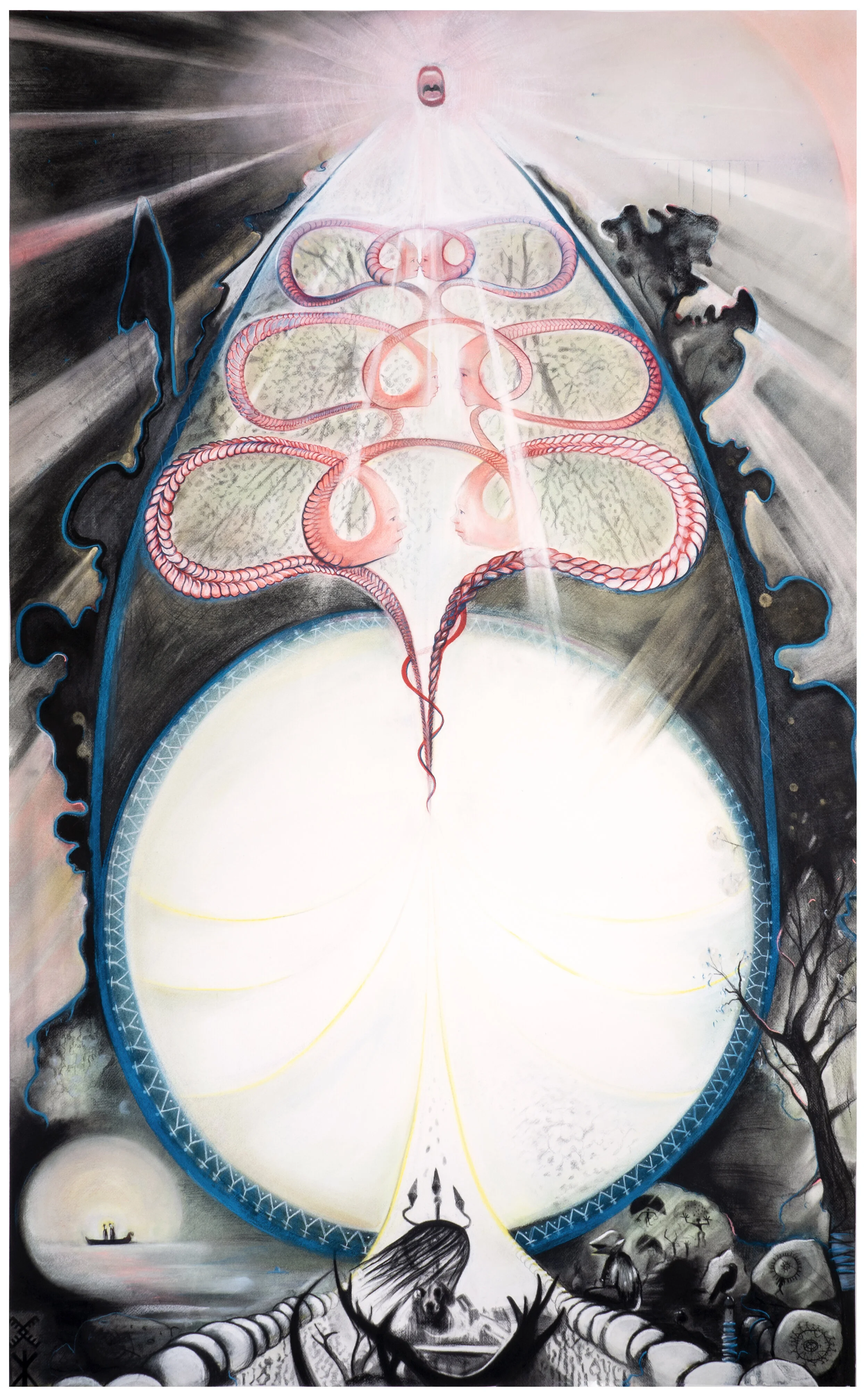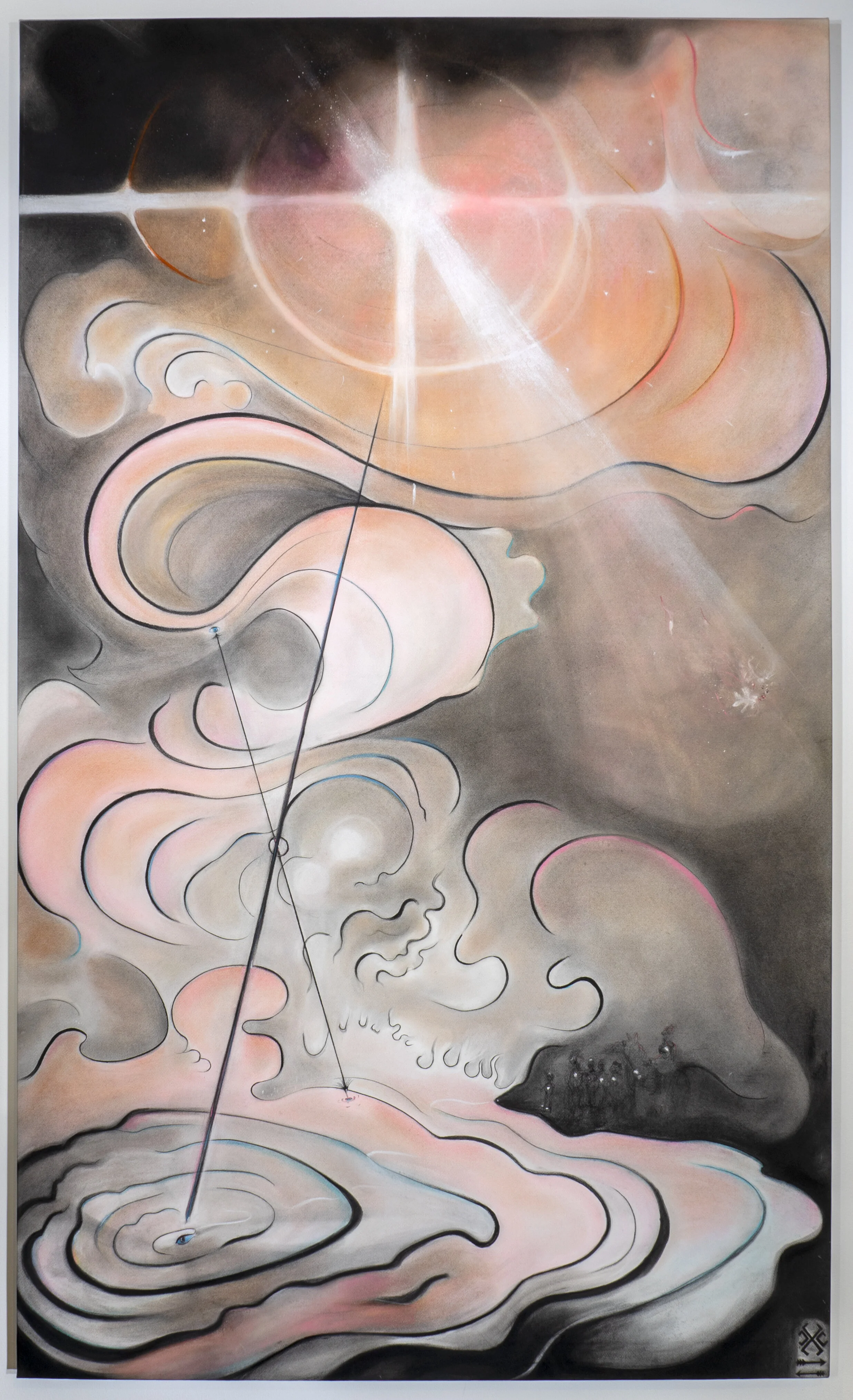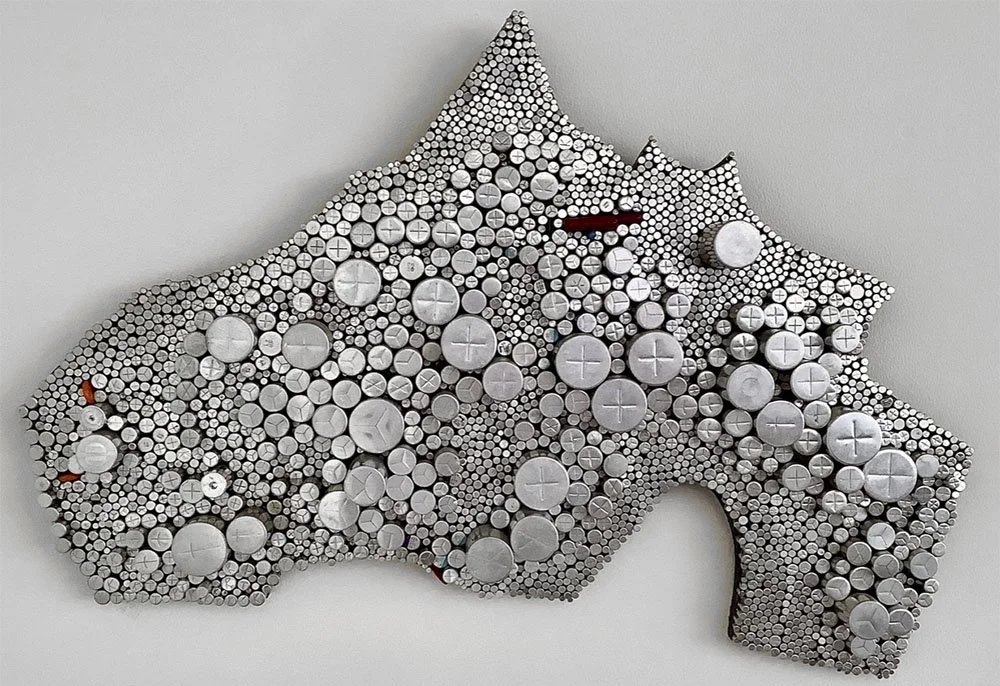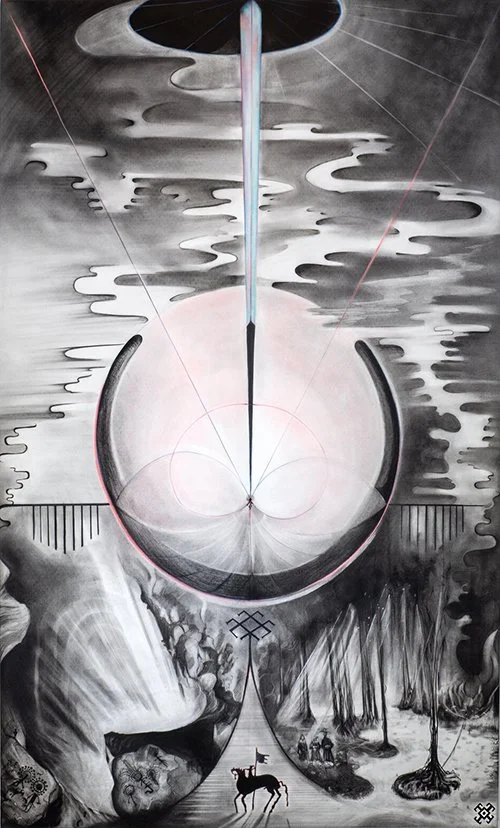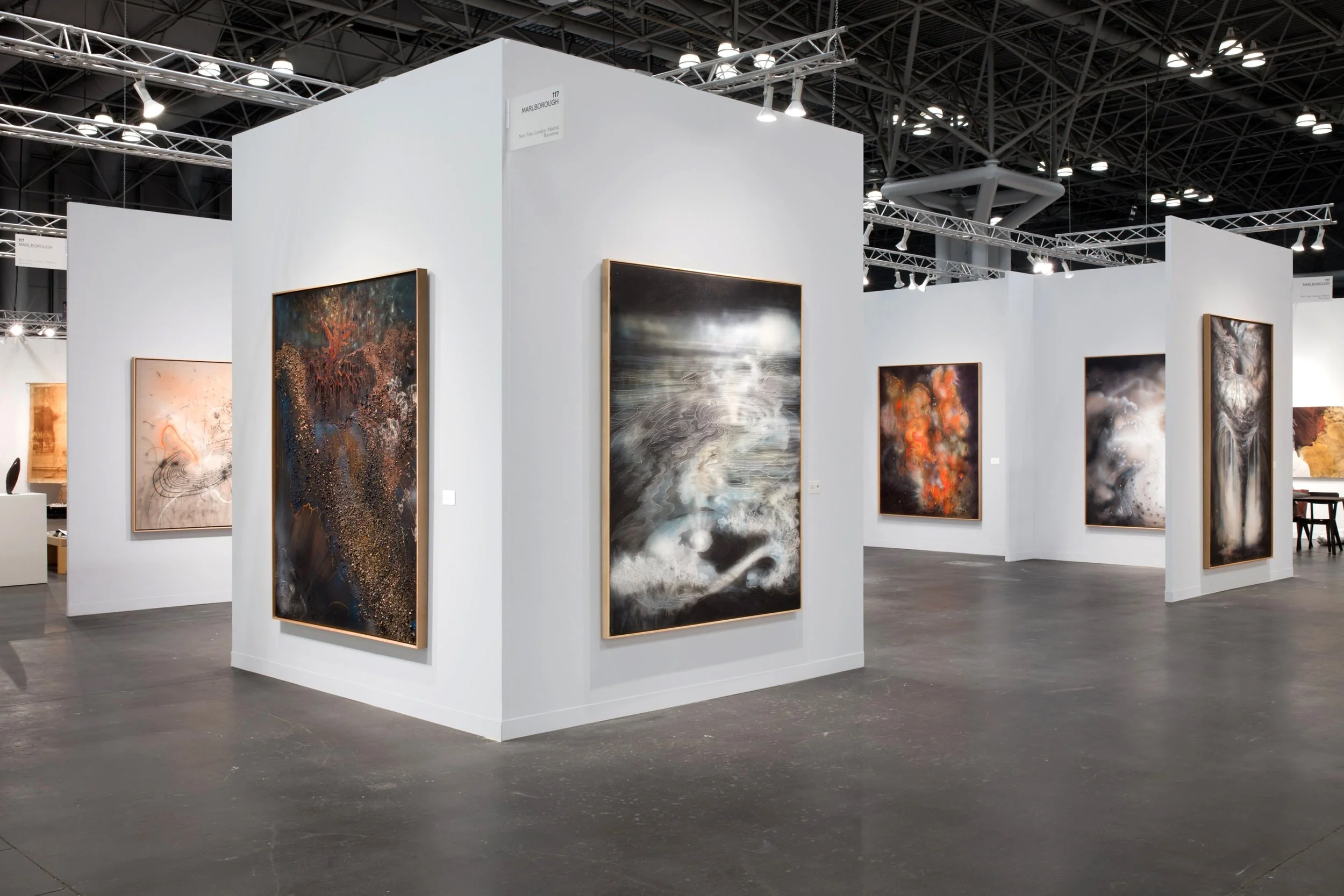Very Yellow White Flash (2022)
R O U N D W E A T H E R
Yulia Pinkusevich: Very Yellow-White Flash
June 3 - July 23, 2022
Opening Reception June 3, 6 - 9 PM
30% of proceeds donated to nonprofits Honor the Earth, Oil Change International, & Sunrise Movement
Floodlight on Yulia Pinkusevich: Very Yellow-White Flash. Round Weather is surprised and thrilled to present prescient and anciently haunted artworks from across Pinkusevich’s career to date. As an emigrant of Kharkiv, Ukraine whose art has long delivered historically psychological charges, Pinkusevich sheds potent light on the current world-reordering war in Ukraine. She has an electric gift for mark-making across human systems and evoking the marks made on us by buried spiritual traditions and mass deaths foretold. Her work also releases that particular energy generated when appreciating art is a form of appreciating life.
Her grand-scale, Tarot-shaped Sakha series feels as though seen from different parts of the eye and mind and is based in Pinkusevich recently learning her maternal ancestors were indigenous Sibereans of the Asiatic Sakha region, a people who practiced shamanism and were pushed toward annihilation by white Russians. The archetypal atmospherics would be at home in the misty pagan passages of Tarkovsky’s Andrei Rublev. Pinkusevich describes how the series “meditates upon the ancient Siberian beliefs that all humans are embodied by three Spirits. The Spirit of Earth, Spirit of the Mother and the Spirit of Air.” The pitch black waving lines in the Sakha series’ Spirit of Air might rest toward the tip of one’s vision while the white flash above feels more as though entering ocular fluid. The light’s inner flesh tones move through smoked milk spaces until received by the back of the eye and skull-crossing visual context. To different degrees (ranging to erasure), we’re all reaching through our bodily imaginaries to our ancestors. Pinkusevich gives this search visual form, an idea underscored by tracing the scattered trail of the surreal blue fish-eye-sperm’s swim to its source: the group (family? tribe?) of shrouded, amorphous light sources with their horse.
Pinkusevich writes that her lively yet meditative Isorithm series begun in 2018 is based in a “Cold War era, declassified military manual which gave step by step instructions on how to create maps that predict the impact of nuclear bomb airbursts; showing fatal and non-fatal casualty isorithms over particular types of habitable regions.” As the title directs, many imagine music in these works’ very orange-red lines, ink, and charcoal notations-gestures-events. In the spirit of Horkheimer and Adorno’s Dialectic of Enlightenment, Pinkusevich writes, “I was struck by the immense tension between the elegant geometries and rational calculations of these maps, juxtaposed against the irrational chaos and mass destruction they represent.” Alexander Nemerov writes of the Isorithm series, “This work is as ranging and inventive as the wind, truly as free as can be—it takes its dose of ‘the real world’ not as a guilt-inducing reduction of that pleasure, not as a required terror that, as it were, ‘allows’ the freedom; but as one and the same thing as the freedom.” Gaston Bachelard writes in Air and Dreams that “air is the very substance of our freedom, the substance of superhuman joy.” Pinkusevich delivers such liberation in one formal flash.
In 2015 Yulia Pinkusevich first made the harp-taut and spray-painterly Silencing the Cacophony. She describes how the Euromaidan protests in Ukraine “began in 2013 after Russia blocked it from entering the European Union. This piece utilizes the aesthetic of protest and media depictions of resistance.” Major braided concerns of Pinkusevich are explored in this work: gestalts of physiological impact and historical imprint. “It captures the energy and feeling of peoples uprisings around the globe,” while utilizing dazzle camo and digital cam obfuscation. The source images are taken from drone and surveillance footage during the Maidan Uprisings in Kyiv. They engage sensations on the ground and sensationalism from above.
Very Yellow-White Flash is a career-spanning exhibition including pieces from Pinkusevich’s series Nuclear Suns, charcoal drawings made in Death Valley, CA of its historic nuclear tests; Mind Maps, robotic machine drawings of the artist’s brain waves during meditation sessions; and Q series, a daily practice during the first months of Covid quarantine where she made an ink mark for each of her breaths. Mushroom spore prints and an installation of red-painted oak galls are also engendered by Pinkusevich’s eye and intellection. Screening is her Manifold video of the ocean’s edge turned on its head. If making a miracle of the ordinary is a primary aim of art, in Manifold art’s mission is accomplished. A vital strain across Pinkusevich’s work are her sculptures of energy–what powers us and our systems. Her Sentiment of an Invisible Omniscience is an electrified wall drawing inspired by panoptic architecture. Her Maximum Capacity sculpture of scavenged capacitors on wood is a beautiful rendering of Silicon Valley wealth concentration. Pinkusevich’s captivating work is wise to panopticapitalism. She also explores what happens when we pull the floodlight’s plug.
Yulia Pinkusevich @ Round Weather
JUNE 20, 2022
by Jaimie Baron
Manifold, 2016m single-channel video, 3 ½ minutes looped
Beginning with the lightning bolt evoked by the title, Very Yellow-White Flash, Yulia Pinkusevich’s new exhibition revolves around the circulation and expenditure of energies. Although they derive from several different series and span more than a decade, Pinkusevich’s works trace how various forms of energy – natural, historical, mystical, disciplinary, activist – move through and across time and space: creating, connecting, dividing, destroying.
One piece in the show is boobytrapped. Touch it with your hand while stepping on an attached metal plate, and a jolt of electricity will make you jump and yelp, even if you’re expecting it. Made from copper wire, ceramic insulators and an electric fence charger, Sentiment of an Invisible Omniscience offers a visual and intensely physical experience of how humans have channeled nature’s marvelous energies into instruments of division, immobilization and repression. These materials – arranged like an aerial view of Bentham’s panoptic prison – are the same as those used in electric fences. Invented for warfare, electrified perimeters now corral both people and animals. Like other gifts of nature, electricity can be liberating or violently oppressive, though sometimes such violence is not immediately apparent. Maximum Capacity, a flat surface composed of the electronic components known as capacitors, is an approximate map of Silicon Valley. During an artist residency at Recology (the San Francisco recycling center and garbage dump), Pinkusevich spent many hours deconstructing old electronic devices to retrieve these parts. As she took apart discarded computers, VCRs and microwaves – reversing the gestures of the assembly line – she wore gloves to avoid toxic chemicals. In the double entendre of its title, which means to hold or store, this wall-mounted piece suggests that the Bay Area may have reached its limit regarding energy consumption and the amount of dangerous waste we continue to generate.
Maximum Capacity, 2014, scavenged capacitors on wood, 17 x 24 x 4 inches
Interdependent Embrace, a hanging installation, shows nature’s energies independent of human aims. Numerous misshapen orbs painted a bright reddish-orange hang from the ceiling like festive ornaments; they are actually painted oak galls, abnormal outgrowths on plants akin to tumors. When a gall wasp lays its larva on a tree, it produces a chemical similar to the tree’s growth hormone, triggering it to produce more cells. The resulting protrusion becomes a nest within which the wasp can hatch and raise its young, evidence of the symbiosis between insects and trees. Similarly, in Spore Goddess and Spore Body 3, Pinkusevich uses the delicate, dusty undersides of mushrooms to print spores directly onto paper, around which she draws and paints. Humanoid figures emerge from within these fungal imprints, as if these mushrooms had transformed into a shape we can understand as sentient, as alive as we are.
This exploration of nature’s energies shifts into a spiritual register in three large vertical paintings – Mother Spirit (ije-kut), Spirit of Air, and The Path (Tree of Life) – all part of the Sakha Series. Pinkusevich was born in Ukraine towards the end of the Soviet period, but some of her ancestors were Sakha, native Siberians whose culture and religion were actively purged under Stalin, beginning in the 1920s. Attempting to trace these lost roots, Pinkusevich incorporates themes from Siberian shamanism into her work: petroglyphs, robed figures and spiritual references. Each painting channels the energies of Pinkusevich’s unknown and unknowable ancestors, calling back to them across generations.
Mother Spirit (ije-kut), 2022, charcoal, pastel on paper, 44 x 74″
Pinkusevich is also interested in the power of mind, the energy that travels through the brain to produce thought. Using imaging technology, she created the Mind Map Series to record her brainwaves as she meditated daily over the course of a month in 2011. This practice generated arrays of intersecting lines representing her brain’s energy flow. When rendered with a Sharpie, the results resemble a schematic drawing of a circuit board or an array of stars. Nearly ten years later, during the pandemic lockdown, Pinkusevich made her Quarantine Series by dipping a brush into water and automatically dropping her hand to paper with each breath, a process that resulted in circles of varying sizes. She then linked the circles with lines to produce a visual network. Both series suggest cartography without a clear referent in real space. However, in contrast to the mind maps, the quarantine images are reminiscent of the maps tracking virus cases that many of us had on constant refresh in the early days of the COVID-19 pandemic. Whereas the mind maps suggest exciting psychic potentialities, however uncertain, these newer works evoke the sense of the world (at least as we knew it) quite possibly coming to an end. Nature may inspire, but it also threatens and infects.
Humans, however, have proven to be our own greatest menace. In the Isorithim Series, Pinkusevich draws on iconography from a declassified Cold War-era manual demonstrating how to predict the effects on the civilian population of nuclear air blasts. In Pinkusevich’s rendition of such maps, the fluid lines indicating topographical variation are overlaid by thick black lines that seem to erupt from the page. By energizing these ostensibly neutral diagrams, Pinkusevich emphasizes the profound gap between our intellectual understanding of nuclear weapons and their actual impact. Like electricity, nuclear energy can raise humanity to new heights of technological achievement and scientific understanding, but it can also – in the wrong hands – just as easily end us. Similarly, Nuclear Sun 4, Pinkusevich’s lush charcoal drawing of a nuclear explosion milliseconds after detonation, captures the fearsome beauty and fascination of such destructive potential.
Silencing the Cacophony, 2015, acrylic, spray paint, oil, vinyl, marker on linen, grommets, rope canvas, 69 x 161 inches
While most of the pieces in the exhibition focus on the harnessing, regulation or hijacking of power, the largest is a case study in competing energies. Silencing the Cacophony, an epic painting that extends beyond its stitched frame onto the gallery wall, shows Kyiv during the Maidan Uprising, which began in 2013 after Russia prevented Ukraine from joining the European Union. These protests transformed into the wider movement against the corrupt, Putin-backed government that eventually led to Zelensky’s democratic election, the Russian invasion of Crimea, and, of course, the current war. Pinkusevich draws on drone and surveillance imagery of Maidan Nezalezhnosti (Independence Square), dramatizing both the actions of the protestors and the harsh reactions against them. Dark smudges obfuscate details while diagonal lines function as “dazzle camouflage,” a technique developed during World War II to generate visual confusion for the enemy. This practice builds on the evolutionary strategies of the zebra, whose stripes conceal the animal by misleading the eyes of potential predators. The perspective positions us so that we look at the scene from above but cannot fully comprehend the target. Pinkusevich observed the Maidan protests from afar, experiencing them only through mediated traces: radio waves, pixels on a screen. Through this painting, which incorporates spray-painted anarchist graffiti and the format of the protest banner, Pinkusevich offers her own powerful gesture of solidarity across geographical distance.
Isorithm 22-7, 2022, acrylic, ink, oil, dry pigment, canvas on panel, 56 x 60″
The strongest piece in the show, however, is Manifold, a single-channel video in which multiple black-and-white images of ocean waves crashing are placed so that they seem to ebb and flow from a central vertical axis, forming an endlessly shifting pattern of light and dark as the waves expand and recede in both directions. At times the water, flecked with ice, appears like sand or oil, producing a textural collage verging on abstraction. This rendering of oceanic energy is disorienting, threatening to overwhelm and submerge us in its flow.
The energies circulating within, around, through and against us are never unidirectional. They move across time and space, for and against justice, propelled by nature alone or redirected by human intentions. This small but varied selection of Pinkusevich’s works urges us to make careful choices about how we deploy the powers at our disposal. Touch or refrain? Reveal or obscure? Remember or forget? Detonate or withdraw? To fight against one another or – like the gall wasp and the oak tree – find a way to coexist?
# # #
Yulia Pinkusevich: “Very Yellow-White Flash” @ Round Weather Gallery through July 23, 2022.
About the author: Jaimie Baron is a professor of media studies at the University of Alberta and a visiting scholar at UC Berkeley. She is the author of The Archive Effect: Found Footage and the Audiovisual Experience of History and Reuse, Misuse, Abuse: The Ethics of Audiovisual Appropriation in the Digital Era. She is the director of the Festival of (In)appropriation and co-editor of Docalogue.


